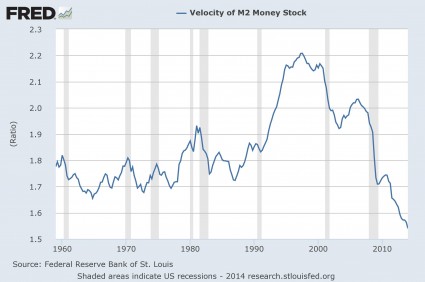When there is lots of economic activity, there is lots of money changing hands. When there is not very much  economic activity, the pace at which money circulates through our system slows down. That is why what is happening in the U.S. right now is so troubling. Let me explain.
economic activity, the pace at which money circulates through our system slows down. That is why what is happening in the U.S. right now is so troubling. Let me explain.
The above are edited excerpts from an article* by Michael Snyder (theeconomiccollapseblog.com) entitled The Velocity Of Money In The U.S. Falls To An All-Time Record Low.
The following article is presented by Lorimer Wilson, editor of www.munKNEE.com (Your Key to Making Money!) and the FREE Market Intelligence Report newsletter (sample here) and has been edited, abridged and/or reformatted (some sub-titles and bold/italics emphases) for the sake of clarity and brevity to ensure a fast and easy read. This paragraph must be included in any article re-posting to avoid copyright infringement.
Snyder goes on to say in further edited excerpts:
When an economy is healthy, there is lots of buying and selling and money tends to move around quite rapidly. Unfortunately, the U.S. economy is the exact opposite of that right now. In fact, as I will document below, the velocity of M2 has fallen to an all-time record low.
- This is a very powerful indicator that we have entered a deflationary era, and
- the Federal Reserve has been attempting to combat this by absolutely flooding the financial system with more money.
- This has created some absolutely massive financial bubbles, but
- it has not fixed what is fundamentally wrong with our economy.
On a very basic level, the amount of economic activity that we are witnessing is not anywhere near where it should be and the flow of money through our economy is very stagnant…
M1
…M1 is a fairly narrow definition of the money supply…[and is defined by] Investopedia as:
- A measure of the most liquid components of the money supply (all physical money, such as coins and currency, as well as demand deposits, checking accounts and Negotiable Order of Withdrawal (NOW) accounts.) that can quickly be converted to currency…
As you can see from the chart posted below, the velocity of M1 normally declines during a recession. Just look at the shaded areas in the chart. Since the end of the last recession, surprisingly, the velocity of M1 has just kept falling and it is now at a nearly 20 year low.
M2
M2 includes more things in the money supply …[and is defined by] Investopedia as:
- A measure of money supply that includes cash and checking deposits (M1) as well as near money. “Near money” in M2 includes savings deposits, money market mutual funds and other time deposits, which are less liquid and not as suitable as exchange mediums but can be quickly converted into cash or checking deposits.
In the chart posted below, we can once again see that the velocity of M2 normally slows down during a recession and we can also see that the velocity of M2 has continued to slow down in the “post-recession era” and has now dropped to the lowest level ever recorded.
Decrease In Economic Activity
This is a highly deflationary chart. It clearly indicates that economic activity in the U.S. has been steadily slowing down and, if we are honest, we have to admit that we are seeing signs of this all around us:
- major retailers are closing down stores at the fastest pace since the collapse of Lehman Brothers,
- consumer confidence is down,
- trading revenues at the big Wall Street banks are way down,
- the steady decline in home sales is more than just a little bit alarming and
- the employment situation in this country is much less promising than we have been led to believe. According to a report put out by the Republicans on the Senate Budget Committee:
- an all-time record 1 out of every 8 men in their prime working years are not in the labor force,
- an additional 2.9 million men are in the labor force but not employed (i.e., they would work if they could find a job) and
- there are also nearly 3 million more men in this age group not working today than there were before the recession began but since they are not counted as part of “the labor force”, the government bureaucrats can keep the “unemployment rate” looking nice and pretty.
Increase in Unemployment
Never before has such a high percentage of men in their prime years been so idle. Of course, if we were actually using honest numbers, the unemployment rate would be in the double digits, our economy would be considered to have been in a recession since about 2005, and everyone would be crying out for an end to “the depression”.
Stay connected!
- Register for our Newsletter (sample here)
- Find us on Facebook
- Follow us on Twitter (#munknee)
- Subscribe via RSS
First Quantitative Easing
…The folks at the Fed know that the U.S. economy would probably drift into a deflationary depression if they just sat back and did nothing so they flooded the system with money in a desperate attempt to revive economic activity. Instead, though, most of the new money just ended up in the pockets of the very wealthy and further increased the divide between those at the top and those at the bottom in this country.
Now Tapering
Fed officials are now slowly scaling back quantitative easing because they apparently believe that the economy is getting “back to normal”….Many are not quite so optimistic. The chief market analyst at the Lindsey Group, Peter Boockvar, for example, believes that the S&P 500 could plummet 15 to 20 percent when quantitative easing finally ends. Others believe that it will be much worse than that.
Conclusion
Since 2008, the size of the Fed balance sheet has grown from less than a trillion dollars to more than four trillion dollars. This unprecedented intervention was able to successfully delay the coming deflationary depression, but it has also made our long-term problems far worse so, when the inevitable crash does arrive, it will be much, much worse than it could have been.
Sadly, most Americans do not understand these things. Most Americans simply trust that our “leaders” know what they are doing so, in the end, most Americans will be completely blindsided by what is coming.
Editor’s Note: The author’s views and conclusions in the above article are unaltered and no personal comments have been included to maintain the integrity of the original post. Furthermore, the views, conclusions and any recommendations offered in this article are not to be construed as an endorsement of such by the editor.
* http://theeconomiccollapseblog.com/archives/the-velocity-of-money-in-the-u-s-falls-to-an-all-time-record-low (Copyright © 2014 The Economic Collapse)
Related Articles:
1. Blame Deflationary Pressures On Current Prices Of Gold & Silver
I believe that the inflation and price charts paint a clear picture, and that until inflation in the world picks up significantly, there will be no meaningful rallies in precious metals…[While] I am bullish on gold and silver long term, the short-term pressure is still evident and might take them lower in the next couple of months. Read More »
2. Tips from TIPS on Prospects for Growth, Outlook for Inflation & Future for Gold
TIPS are telling us that the market is quite pessimistic about the prospects for real growth, but not concerned at all about the outlook for inflation. Read More »
3. Probability of Deflation Is 60%, Inflation Is 25% and Muddling Through Is 15% – Here’s Why
At the end of last year virtually every every single economist expected interest rates to rise this year as the Fed tapered their purchases and the economy improved but, in fact, interest rates on the 10 year U.S. Treasury have been going down year to date (from 3% to 2.5% after rising from about 1.6% to 3% last year). The masses, going along with this crowd, got fooled but we have been calling for a decline in interest rates for some time now due to world-wide deflation and it couldn’t be clearer to us that this is the most likely scenario for the United States. Let us explain. Read More »
4. “Liquidity Trap” is Fast Approaching
When velocity is low the nation essentially winds up in a “liquidity trap” which is a situation where monetary policy is unable to stimulate the economy either through lowering interest rates or increasing the money supply. This was the condition that Japan found itself enveloped in from 1989 to present. We expect the same problem in this country and hope (really hope) to be wrong. Words: 672 Read More »
5. We’re Headed for Crippling Deflation First & Then Rampant Inflation – Here’s Why
Are we headed for rampant inflation or crippling deflation? I believe that we will see both. The next major financial panic will cause a substantial deflationary wave first, and after that we will see unprecedented inflation as the central bankers and our politicians respond to the financial crisis. [Let me explain why I think that will unfold.] Words: 1025 Charts: 3 Read More »
6. 15 Questions & Answers Regarding Hyperinflation
It is difficult to say exactly when hyperinflation will hit a currency. However, I am convinced that the danger level is so high for most fiat money that it is worthwhile for everyone to increase their understanding of hyperinflation. This is the first part of a Hyperinflation FAQ for frequently asked questions or objections about hyperinflation. Words: 1600 Read More »
7. Now Underway: A Spiral of Debt Deflation Into a Bottomless Economic Abyss!
von Mises once said, “There is no means of avoiding the final collapse of a boom brought about by credit expansion. The alternative is only whether the crisis should come sooner as the result of a voluntary abandonment of further credit expansion, or later, as a final and total catastrophe of the currency involved” and just that is happening before our very eyes. Words: 2242 Read More »
8. Risk for the Economy is Deflation, NOT Inflation
Presently, the federal government is increasing spending that in the end may actually retard economic activity, and is also proposing tax increases that will further restrain private sector growth. In other words, fiscal policy is executing a program that is 180 degrees opposite from what it should be to stimulate the economy. How is it possible to get an inflationary cocktail out of deflationary ingredients? Words: 1461 Read More »
9. Deflationary Pressures In Economy Are Primary Concern of the Fed
Despite the Fed’s recent communications that they are planning to “taper” the current monetary program by the end of this year – the index is suggesting that their interventions, in one form or another, are unlikely to end anytime soon. The threat of “deflation” remains the Fed’s primary concern. Read More »
10. Deflation: What You Need to Know (and Fear) & How to Prepare for Such an Eventuality
All in all, deflation should be one of the most serious words in a commodity investor’s vocabulary and is something to always keep an eye on. While its presence may seem removed from our economy, the possibility always remains and preparation will be key to survive a deflationary environment. Read More »
 munKNEE.com Your Key to Making Money
munKNEE.com Your Key to Making Money





The major advantage of credit cards that have petitioned to most people is the fact that, even if you do not have cash in bank, you can make essential purchases.
Almost all states will provide you with one free credit report each
year. Neither does telling a collector you are aware of an old (SOL-expired) debt, or can’t pay back the debt.